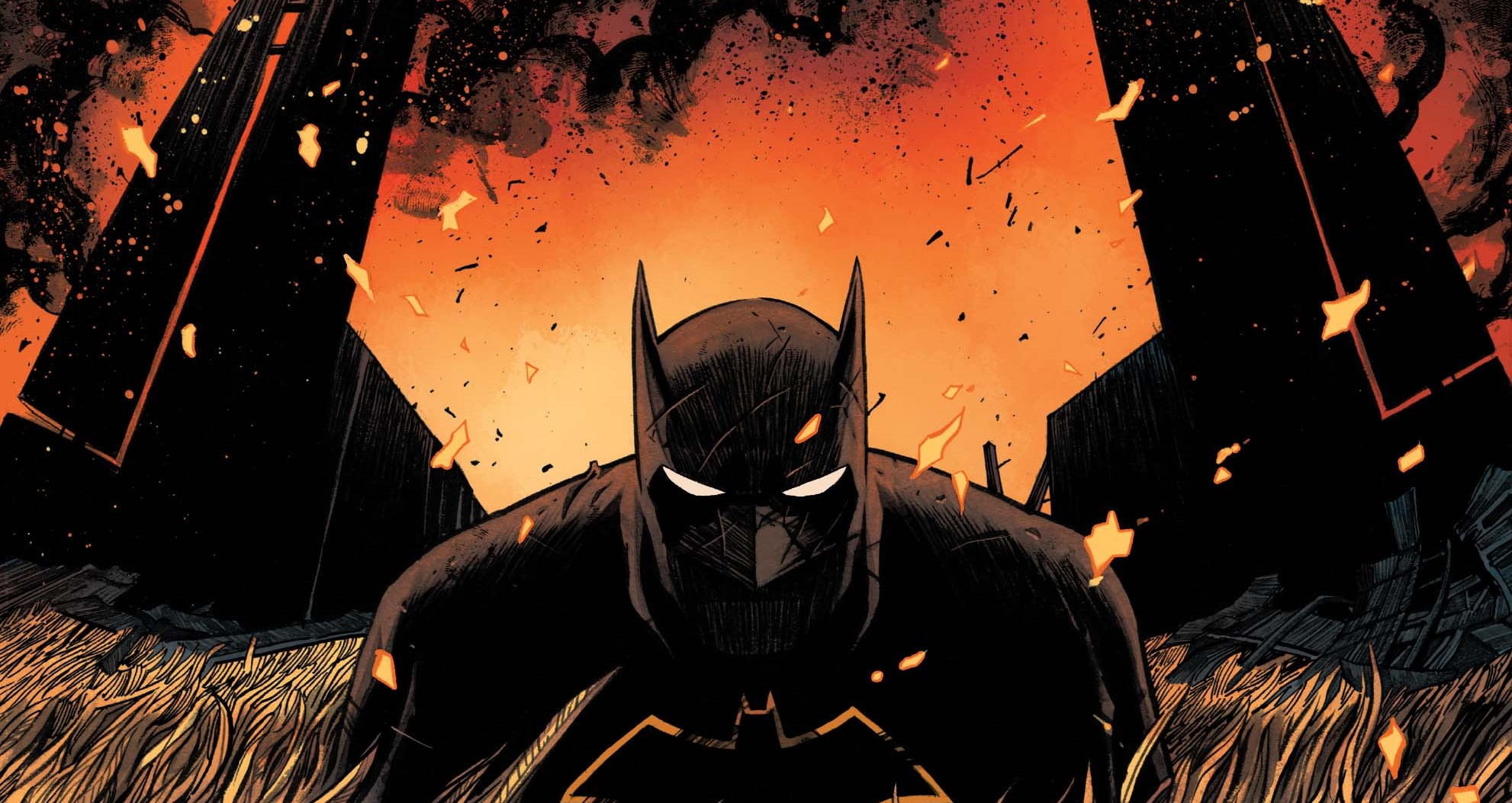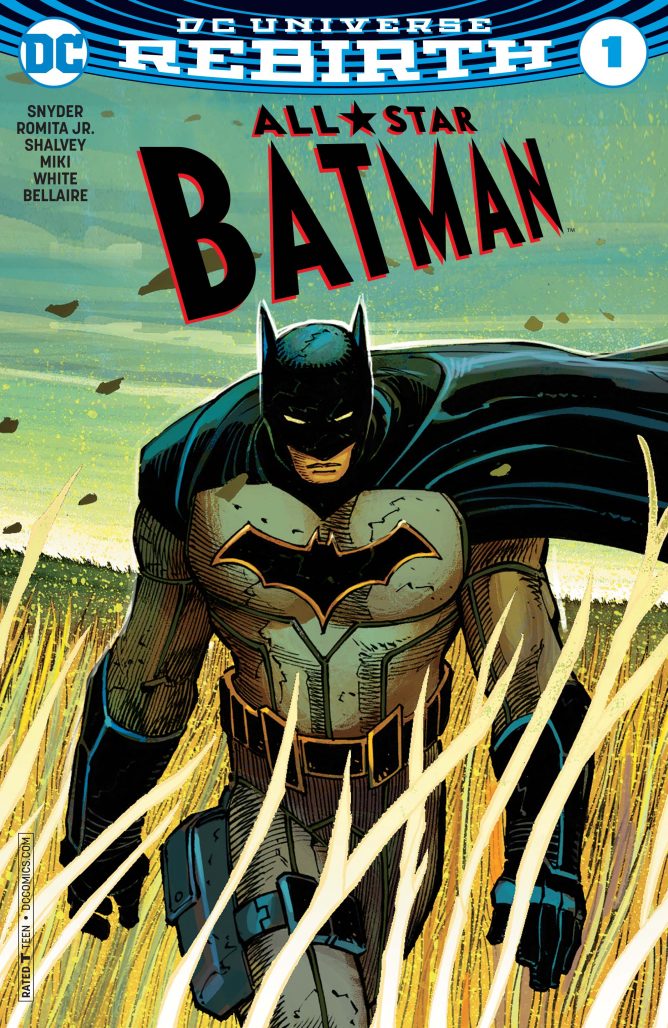
On Tuesday, Comics Beat editors Kyle Pinion and Alex Lu released the first part of their interview about All-Star Batman #1. Today, we present the second part of our discussion where we dive into spoiler-heavy discussion on the book’s themes, structural presentation, and the threads that carry over from Snyder’s run on Batman into this new series.
Alex Lu: One cultural touchstone I was thinking about when I was thinking about All-Star Batman #1 was Joker’s deal in the middle of Christopher Nolan’s The Dark Knight where The Joker says he’ll blow up a hospital unless a Gothamite assassinates Coleman Reese, who has gone on live TV to reveal Batman’s identity. How would you compare Nolan’s Joker to your version of Two-Face?
Scott Snyder: Well the thing I loved about that version of The Joker was that he sort of reveled in the craziness of the world and that sense of chaos. I think our version of The Joker was not incredibly different from that but was slightly more personal to me– it goes beyond him saying “I want to watch the world burn.” It’s more personal in that he’s trying to prove a point, which is that nothing that we do has any relevance. When I’m going through a bad period, that’s the hole I fall into: “What is the point? Why bother with anything?” The magnitude of death and how quickly everything is racing towards that is really overwhelming when I’m not myself. What our version of Joker says to Batman is just that. He is very much the void where he’s saying “Your family was killed by random violence.” Everything is subject to cosmic randomness.
Beyond that, he’s trying to make an even darker point, which is that by trying to do anything in life or making meaning of it, you’re a joke to him. He’ll show you why there’s no point, there’s no meaning.
Two-Face, for me, is different. There is something [about him that] I’m sure [is] similar to Nolan’s Joker because I love that version so much. However, he really is a character who isn’t convinced that things are chaos or random or meaningless. He believes deeply that we are selfish, purposeful animals and that everybody wants things– they just cover themselves up all the time. They deny themselves happiness. What he wants is for us to give into those things and to admit that we’re as ugly as he is.
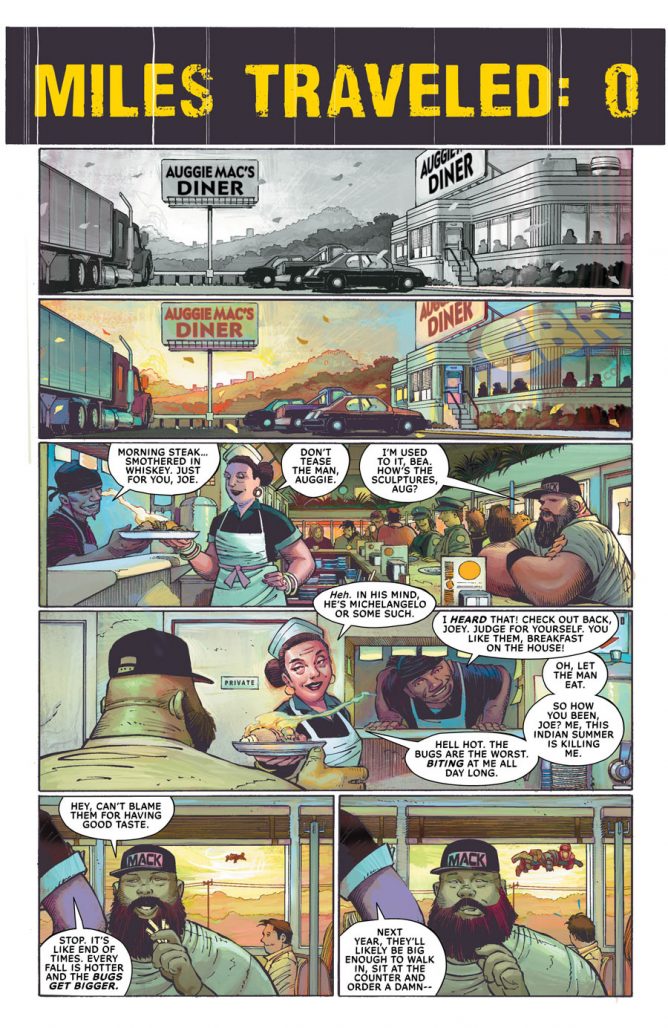
Kyle Pinion: Throughout the issue, you utilize an interesting narrative technique where you loop back and forth through different moments in time, going from “22 minutes ago” to “two hours ago” to “two weeks ago” and back to “twenty minutes ago.”It plays to Two-Face, obviously, but I’m kind of curious – I don’t think I’ve seen you use a formalist technique like this before, at least not in such a strict sense, anyway. It even has a bit of a Grindhouse feel, with the “Miles Travelled” heading with the worn out film-reel look. What’s the driving inspiration here and what prompts you to utilize different storytelling tools?
Snyder: Well the most important thing for me going into the book was to do something that was a challenge and surprising to me as a writer, given all the stories I’ve done on Batman so far. It was about developing not just a story that would take me somewhere that I hadn’t been before emotionally or psychologically, but also developing a whole new way of telling that story. I tried to do that throughout our time on Batman with “The Black Mirror,” which was a very compartmentalized detective story and very grounded. Then, “Court of Owls” was my first stab at something that was really big, monolithic, and epic. “Death of the Family” was horror and “Zero Year” was much more zany and colorful. I was always trying, at least, for better or worse, and I’m sure I failed a few times, to do something I hadn’t done before, but All-Star Batman just opened up that possibility so broadly.
The aesthetic, in particular– I wanted something that said “danger” and said “excitement” and said “this story is going to move differently”. Two-Face has this line in the issue where he says “I’m the mirror to this time” and I thought maybe I’d take the line out because I didn’t want it to be too on the nose. You can never really be too on the nose– or you can– but in comics I feel like a lot of the time people forgive you for being on the nose if you have that impulse. I certainly lean in that direction rather than always going for subtlety, I know, and I’m trying to work on it. However, what I’m getting at is I wanted to try and create a structure that would have a corollary in Two-Face’s philosophy where he says: “People don’t like to look at themselves. I ask them to look deeper and deeper and see themselves and come back ok with it– to say this is who I am.”
Every issue, at first, is structured in this mirror way where it kind of moves backwards through time and then back through those periods to the present. It starts in the present, moves back in time, further back in time, hits a bedrock, and then moves back through those same periods, even if briefly, to the present. I do start to vary things a bit in the later issues by showing what Bruce is thinking instead of always showing a flashback. However, if he’s remembering something as opposed to Romita and me showing you the past event in a flashback, I don’t count it as a part of the structure I’m playing with. I’m getting way too granular though.
The point is, I was trying to find ways of telling the story that wouldn’t just feel like they were experimentation for experimentation’s sake, but had parallels or had an anchor in the sensibility of the story, the point of the story, what it’s about, all that stuff. It was a really fun challenge and it was very much about trying to create something that felt organic and part of a singular vision while still being surprising and different.
Lu: Another interesting narrative shift in the way that you wrote this story was that Batman didn’t have an internal monologue. In most of your Batman arcs, those thoughts were often the foundation of the thematic exploration. What does it mean to you to create such an opaque story, one that doesn’t give you a look into Batman’s head and tell you how he feels about the events around him?
Snyder: I look at those different elements and tools– in “Zero Year” for example, I didn’t use captions for that entire year because I wanted it to feel faster, more colorful, and also be like an inversion of Year One. In All-Star Batman, I felt that captions would offer a reader familiarity and intimacy, almost a safety net of some kind that felt inappropriate for the story that it is. You are exposed and you are out in the middle of nowhere. You never know what is going to hit you. My goal was to not use any captions and to structure the book with these very fast scenes that had lots of action and bewilderment in terms of where the story is going to take you next.
Pinion: Is there any coincidence that the bug villains are fighting Batman in a rural country setting?
Snyder: That was the fun at first, to sort of group them together and also have them be the pest that he can’t get rid of, the things that kind of eat him at the end. I also love Killer Moth and Firefly as a team. I always enjoy them, and I really enjoy Black Spider from Gotham Central too.
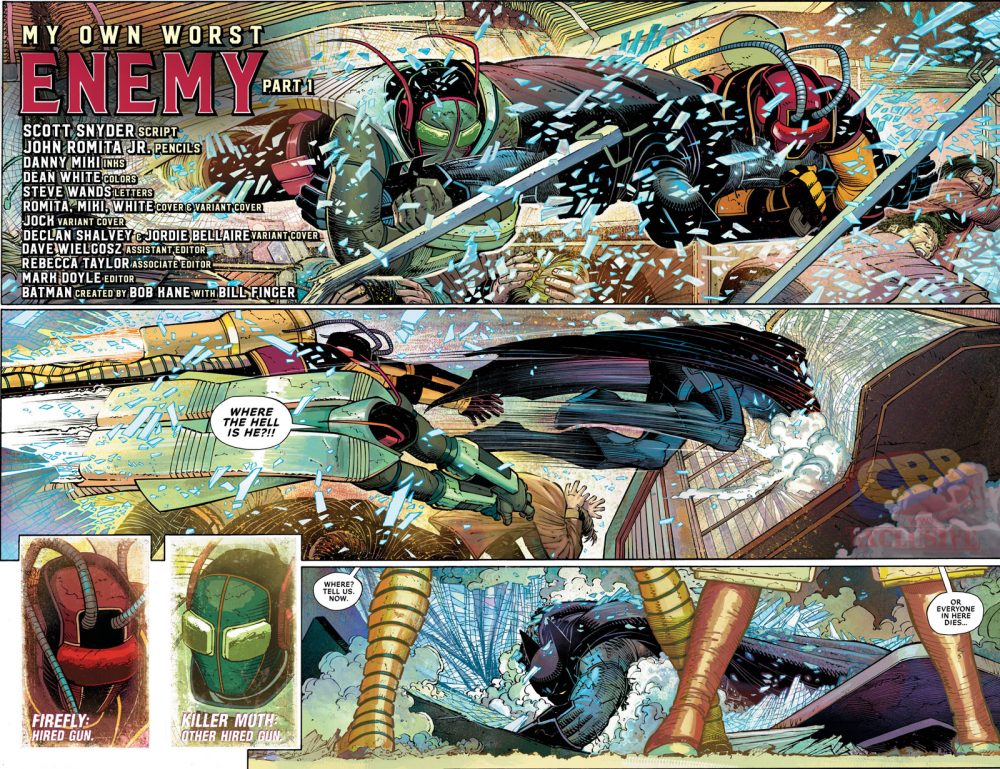
Pinion: Gentlemen Ghost is coming and that hits me where I live Snyder, so I’m very excited about that.
Snyder: Yeah, and KGBeast is the big bad in the whole arc– I’m really excited about that one. He’s reinvented in All-Star Batman. After the fall of the Soviet Union, our government took him in and enhanced him. Now he’s at the end of his tenure and he’s looking to go into business for himself. This story is full of villains– the Royal Flush Gang is coming in too. On the one hand, it’s fun and joyous, and celebratory, but on the other hand, there’s a real point to it. The story has an underpinning that sort of justifies the goofiness, I hope.
Pinion: Is the backup story being used to give further shading to Duke?
Snyder: Yes. Not to give too much away, but the backups take place before the features. If the features take place post-Two-Face’s attack on Gotham with the acid rain, then the backups are actually the prequel. It ends with Two-Face coming to town and that arrival is a catalyst for some of the events in the backup story as well.
I’m so thrilled to be working with Declan and Jordie, we are very close friends. We sort of went on a vacation to a trip to Ireland to a con with my wife and we all really hit it off and we’ve been friends ever since. Working with Declan has been a huge thrill. The first arc is five issues and the first story is called “The Cursed Wheel.” Those backup stories tell the tale of Duke’s progression over a year-long basis where he becomes the hero that he is meant to be. It was fun figuring out where to land him and what his character has to offer in terms of what are some of his stronger qualities and what kinds of heroes do we not have in the DCU. I think we have something that is perfect for this character. I’m really excited about the backups– they will tell stories about different colors and the colors have corresponding elements and correspond to the meanings of the villains in the features as well. During the Two-Face arc, the backups are all in the black section of the wheel. The Mr. Freeze Story is the white section of the wheel. The Poison Ivy story is the green section of the wheel and Catwoman is in the red.
Lu: Back when you created Duke Thomas during the Zero Year arc, did you know that he was going to play such a prominent role in the DCU later on?
Snyder: No. I realized that I wanted to create a character like Harper Row that would give me a sort of embedded view of the city. Harper ended up becoming a superhero, and we talked about her possibly being a Robin or another character. I love her and she and her brother have this whole story that is going to happen in Detective, but with Duke I was more protective. I wanted to explore his character when I had a chance. I didn’t want him to immediately become a superhero or something like that. To be perfectly frank, I think there were different impulses at DC at different times. I’m not discrediting any of it, I just think there were moments where DC wanted him to become a superhero very fast and I think there were other moments where there was a lot of reluctance to push him into a costume so he would have more time to develop.
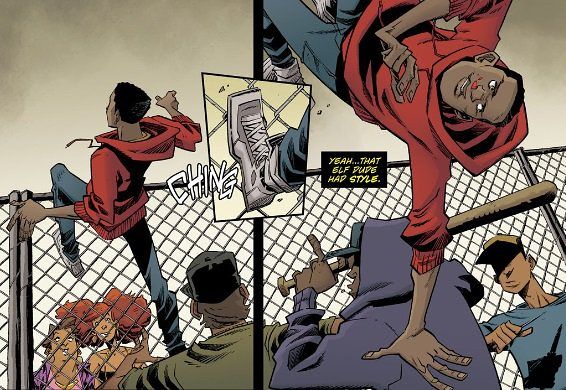
I wanted to develop him as a character outside of a costume. I wanted time to make sure that wherever he goes, he has a good, strong place in the DCU. When Lee Bermejo pitched We Are…Robin…that for me just felt like a perfect place for him to develop. I was definitely up for him being an official Robin for a while, but there was a lot invested into Damian being Robin in the Teen Titans. All of that kind of stuff was already in the mechanics of the line, so it was a hard argument to make. I completely understand why they wanted more of a focus on Damian in terms of him wearing the Robin mantle. To be totally fair, it felt better for me to be able to say: he was Robin in his own iteration in both our story and “Superheavy,” but more importantly in We Are…Robin because he is a character who believes at his core that Robin is a movement. Robins are the people inspired by Batman to be heroes in their own way. It is independent of Batman. Robin doesn’t need a Batman. I love that aspect of that character, so it felt disingenuous to put him in the Robin costume.
Lu: There have been hints dropped in All-Star Batman #1 and in Batman: Rebirth #1 with Mikel Janin and Tom King that Duke has been training to become something better than Robin. Could it be that he is being trained to become Batman himself?
Snyder: Well you will have to see. I’ll say that DC has thrown around a lot of different possibilities. You never know. I’ve been getting a lot of requests from other writers asking to write him into their books and there are ideas all over the place in terms of what role he can take on in Gotham, but I really think that I’m excited about where he’s going to be. I really think it will give him a place that isn’t occupied by anybody.
I didn’t want him to feel superfluous, I don’t want him to come into the Gotham world and then be sort of like: “hey, look it’s an African American character in the Gotham world and he doesn’t have a place beyond that.” That would be very upsetting to me. I want to make sure he’s got the right legs as a character and I want to make sure that he the right perspective. He’s a hero that can really stand on his own despite whether he is near Batman or not, I want to develop him to be someone who could support his own series.
Lu: If every character has a color of a wheel, maybe there’s a color that hasn’t been used that could be Duke’s.
Snyder: Yeah!
Lu: Was there ever a shift in Harper’s role in the DCU overtime? When she was introduced it seemed like she was going to be the next Robin.
Snyder: Yeah, there are always shifts. When you get to the point when you are working on the main book and you create a character, there are different pushes and pulls from editorial and from higher up and all over the place that say: “do you know where this person should land? Do you know what we should do because it would sell comics? Do you know what we should do because it would be the right decision to sell the character over time?”
You get all sort of different suggestions and the hard thing is that some things are very tempting that would be wrong for the character, while other things are tougher that are right for the character. For me, I thought maybe Harper would be Robin in a couple of moments, but with Damian coming back the way he was, it felt like it would be too on top of each other and too overlapping– it’s one of the reasons why, as much as I would love for him to be Robin next to Batman in costume, I’m not incredibly fond of Duke being Robin, even though he was in “Superheavy” and at times in We Are…Robin. There’s a part of me that feels like he would be just another character that steps up to be a Robin in the mantle who will always feel secondary to Damian leading the Teen Titans; to a Robin that has been established over ten years. If you are going to be Robin, you have to be the only one. I felt that Duke built a different kind of identity as Robin. Does that make sense?
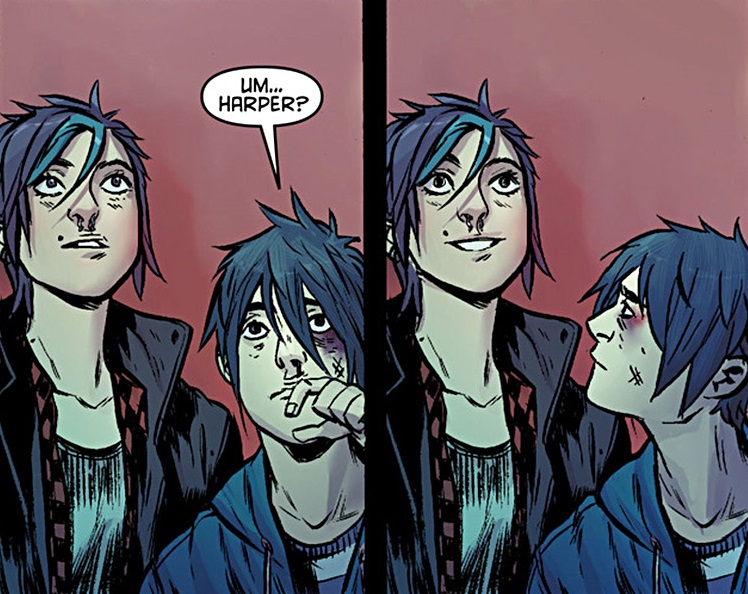
Lu: Absolutely, you’ve created a ton of characters in your time writing Batman, it makes sense that they weren’t all going to land where you originally thought they would land.
Snyder: Neither Duke, not Harper were created to be a Robin, she was created to be a character that would be someone who could help Batman get a ground level view of Gotham and bring him into some almost Gotham Central type issues. Then, what happened was that she started to develop as a character who could be a monkey wrench for Batman. Damian was going away for a while; I don’t know if he already died or was about to die in Grant Morrison’s stuff. There began to be talk about whether she could take over that sidekick role. There were days when we talked about her possibly becoming Robin, and then we decided maybe we would create a new identity for her. It was all brainstorming. It was never: “this character was made to be Robin and now that door is shut”, she was meant to be an organic figure of Gotham that would give more a lens to the city. As different opportunities started to pop up, occasionally there are things that make you think: that you would be really cool and the next day you realize that doesn’t feel right.
We decided that with Batman Eternal, we could build her up even more and I got all excited about it. Occasionally, I get bummed out because I don’t have room to really bring her in now with the way that I could with Eternal. My hope is that she will end up in Birds of Prey, maybe one day something like that could happen. DC has been very generous with helping me create new characters and giving me room to be involved in the direction that they went in. I hope that I made good decisions with them.
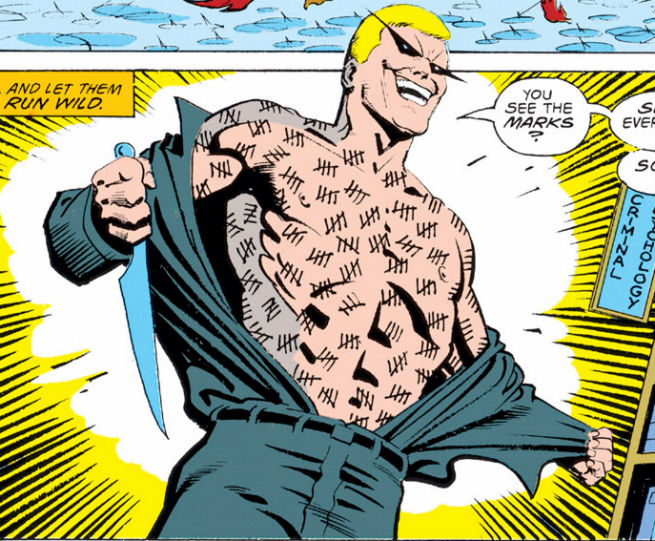
Pinion: When I was about 10 or 11, I read the first few issues of Shadow of the Bat. Mr. Zsasz was one of the most terrifying Batman villains that I could have ever encountered. To this day, I still kind of find him pretty frightening, even compared to The Joker. There is just something very real and very tangible about Zsasz’s brand of evil that you could see on the news today. When Batman talks about the black portion of the color wheel, he discusses evil and its nature. I feel like that’s very appropriate for Zsasz.
Snyder: I always have been fascinated with how terrifying serial killers are. I was always a big horror movie buff, but the ones that terrified me the most were not monster films, but serial killer movies. The thing that’s scary about them is that there is no reasoning with why they are there. They are functioning with some kind of private ideology that is coming for you and you cannot talk your way out of it–there’s no mercy. There’s something that is a force of nature terror about it– where you are working with a completely different set of rules and priorities.
Zsasz is that force of nature, but in that Gotham way. He’s not only a sort of a serial killer, but enhanced if you look at him as sort a serial killer and see all the notches on his body representing the people that he’s killed and reduced to just these marks on him speaks to just how terrifying he is because all you will become is that mark on him.
Pinion: Especially at the end of the first backup where you have the young women screaming: “KILL ME!”– that’s a very haunting image. I think the sheer horror that is his aftermath is very clear even in the short amount of time that we get with this story.
On that note, do you feel any whiplash when you script this more internalized, psychological story with Declan and then write the action-packed main story with John?
Snyder: That’s the joy of it for me. I’m already crafting my next project with Greg Capullo. I miss him and we talk like every couple of days–he’s become a member of the family. We have this sort of way of talking to each other– we have a sort of shorthand where, by the end, we are pushing each other towards things that we don’t realize that we are capable of. With Greg, we are constantly exciting or renewed. In working with any artist, you figure out what they like to draw and what they respond to.
That’s why I felt comfortable within “Superheavy,” for example, doing that issue with Brian Azzarello and Jock. If Greg was drawing that issue it would have been very different. We translated that issue into more realistic language with a more street-level story of a young African American character in Gotham who makes some bad choices and ends up completely victimized by the city. That story, if I was doing it with Greg, might have been translated into more bombastic comic book language. If I was working with a different artist with “Zero Year,” I would have made it much more gritty and realistic, if I was working with a different artist than that, I might have made it more cartoony and bombastic– you find a sweet spot for each artist.
When I talked to Declan and Jordie before I started, I was saying: “what kinds of things do you like to draw?” If they had said to me: “look we don’t want to be in Gotham, we want draw crazy stuff with Batman in space or in the sky,” I would have tried to find a way to tell the same story with different set pieces and tone– with whatever that artist felt like doing. That was why Becky was so great for Batman #12. Talking to her, she wanted to do real life in Gotham and that’s what engendered that story with her.
Pinion: And certainly every artist brings a different sense and tone. Romita draws high octane, muscular superhero stories, whereas Declan pitches more towards psychologically stirring material…
Snyder: I want every issue to have very different components. My hope is to have someone like Tim Sale on the backup and have that mix of an artist that is associated with Batman with someone who is incredibly new. I want to constantly try and find a balance. If John is very muscular, very kinetic, but blockbuster Batman, I want Jordie and Declan to use exaggerated qualities. Declan picks things to exaggerate in order to bring out a mood. There are different things on the spectrum artistically. I want Paul Pope’s story to be as crazy as possible.
Lu: What better way to highlight Jordie than to give the arc focused on the color wheel?
Snyder: That was part of it too, this whole story is about color and how sort of enticing and scary it could be. Even the choice of putting it in. It’s really a joy to work with both of them.
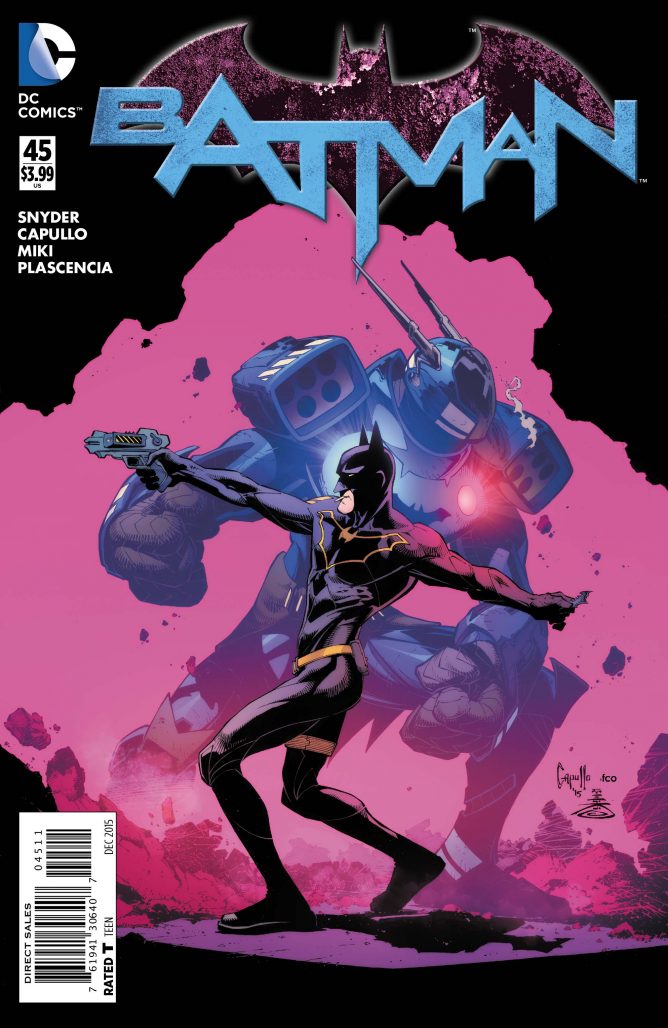
Lu: As much as All-Star Batman is a celebration of all the villains in the series, would you say the series is also a celebration of Batman as a hero?
Snyder: Oh, always. I hope, if we made one contribution with the Batman run with Greg and Danny, FCO and John, that we sort of push forward the notion that Batman is not just about intimidating others to go back into the shadows the way he did when I was a kid– it was a super noble and heroic version of the character. In today’s post-9/11 world, he’s about bringing good people into the light and inspiring bravery in people facing insurmountable problems, whether they are personal or community-wide or city-wide or statewide or national, he will always be that. That’s very much baked into the DNA of my interpretation of Batman, that won’t change.
When I say All-Star Batman a celebration of villainy too I don’t see it as necessarily it as a book that is intensely dark. It’s more a celebration of the fun we take in looking at our darker sides and personal demons, only to be able to hopefully overcome them. It’s a dark story. When I think about the end, there’s darkness to it. But really, we all know Batman always wins and will be a symbol of hope and inspiration to us. People always kid me when they say that “Batman always wins, it’s such a joke,” it becomes a sort of comedic relief in Batman comics. However, I was talking to Tom King the other day and I was saying that there’s something deeply important about the fact that Batman always wins even if it is done to humorous effect or to some extreme extension. He’s not only one of the human characters with no powers in the Justice League, but he’s also a figure whose whole mission in life is to take something random and tragic and horrible and turn it into fuel that will make meaning out of his life.
Whatever he faces, that conflict is projected onto it. If he’s facing the Riddler or facing street thugs, the bigger or more insurmountable the problem is, the bigger win that he gets, the more potent that lesson that “no matter what you’re facing, you can overcome it,” becomes. I know that sounds sort of silly, but when you see kids from all walks of life wearing Batman t-shirts– I thought about this a lot when I was writing “Superheavy” because that story was largely about what Batman hopefully means to a world where he doesn’t exist. In a world with all these entrenched challenges, why do we care about a hero who is fictional?
I think, really, when you write the character in anything When you write the character and you see a kid from inner city or the country wearing a Batman t-shirt and you wonder “why?” it’s not because he has this amazing costume and awesome car. There’s a deeply captivating and motivating quality to that core belief: which is that he always wins. It’s not even that he always triumphs in this amazing way– winning is coming back up and fighting over and over.
Lu: I really enjoyed how “Superheavy” took us away from the familiar trappings of a Batman story and asked us to adapt to something new. How does that element of the conclusion to your Batman run carry into All-Star Batman?
Snyder: There’s a power in seeing Batman in these strange environments and showing how adaptable he is in All-Star, largely because I think the things that he makes us unafraid of are more national issues. He doesn’t only exist in a shadowy Gotham. He exists for somebody who lives in a place outside of an urban setting and is worried about gun violence or terrorism. To see Batman pop up in a field in a story, to me there’s something as potent about it as there is about seeing the villains pop up in your hometown. There’s scary but there’s Batman out of nowhere, in a place you thought you’d never see him, saying “be brave.”
Grant (Morrison) always said to make use of Batman’s adaptability because it was his favorite thing about him. One of the fun things about Batman is exploring his adaptability at this particular moment because what it means for him to be a hero so broadly demands that you reconfigure how you tell stories with him. How do you write Batman in a way that makes us brave in the face of these larger than life threats that have become very real for us but aren’t punchable, I hope a lot of that comes through in the series as we go forward.
Next month raises the stakes with Two-Face with and KGBeast.
All-Star Batman #1 is in stores now!


